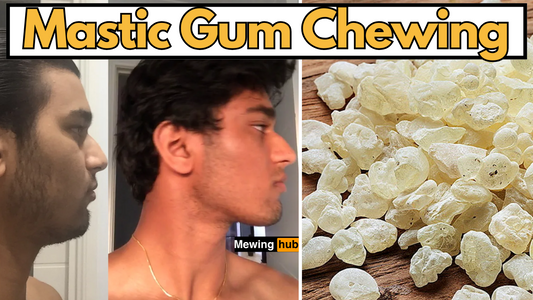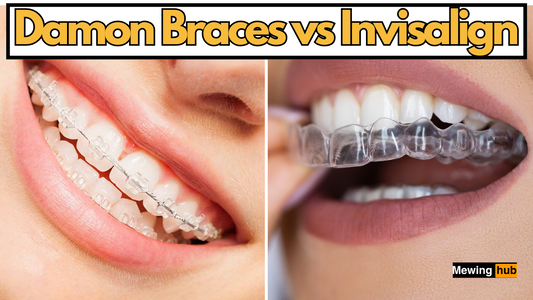Understanding the Science of Mewing: How Does It Work?

Share

Understanding Mewing
How Does Mewing Work?
This practice, developed by the British orthodontist Dr. John Mew, revolves around properly positioning the tongue against the roof of the mouth.
This constant pressure on the palate and on the maxilla (the bone located at the palate) is said to widen and expand the palate and thus the maxilla.

Thought to positively influence facial structures, mewing could lead to enhanced facial symmetry, improved jaw alignment, and better overall facial aesthetics.
The Technique of Mewing
Proper Tongue Positioning
Mewing involves resting the full tongue—both the front and back parts—against the palate. This continuous practice, ideally maintained throughout the day and even during sleep, also requires the lips to be closed and breathing through the nose. This technique is believed to retrain the face and neck muscles, potentially causing long-term changes in facial structure.
To understand the correct method and achieve the best results, you can read our detailed guide on How to Properly Mew? A Complete Guide! which covers everything you need to know about this transformative practice.
The Science Behind Mewing
Facial Bone Remodeling
The foundation of mewing lies in the belief that the facial skeleton, especially the maxilla, is adaptable and responsive to external forces like the tongue's pressure. Dr. Mew's hypothesis posits that proper tongue posture can stimulate remodeling and growth in the facial bones, resulting in structural changes over time.
This concept is supported by Wolff's Law, which states that bone in a healthy person or animal will adapt to the loads under which it is placed.
When the maxilla receives consistent pressure from the tongue, it may remodel to accommodate this pressure, leading to potential changes in facial structure and alignment.
Role of the Tongue in Facial Development
The Power of Tongue Posture
The tongue is a powerful muscle significantly influencing facial development. When correctly positioned, it applies even pressure on the maxilla.
This pressure is theorized to encourage the maxilla's forward and upward growth, potentially enhancing facial symmetry and leading to a defined jawline and improved facial harmony.
Research indicates that muscle function can influence bone structure, supporting the idea that proper tongue posture could lead to changes in the facial skeleton.
Nasal Breathing in Mewing
Importance of Nasal Breathing
Nasal breathing is a pivotal aspect of mewing. Mouth breathing might result in a lower, more backward tongue posture, potentially affecting facial development unfavorably.
In contrast, mewing and breathing through the nose exert sideways and upward pressure on the maxilla, theoretically widening the palate and allowing more airflow and improved nasal breathing.
Studies have shown that nasal breathing is crucial for proper craniofacial development, which aligns with the principles of mewing.
Long-Term Effects of Mewing
The Gradual Changes and Benefits of Mewing

Mewing requires patience and consistency, as the changes it brings are gradual. The plasticity of facial bones diminishes with age, so starting mewing early can have a more substantial impact. Adults may notice better facial symmetry and posture, improved jawline definition, and a wider, more chiseled face.
Mewing and the Eye Area
Impact on the Eye Area
Mewing is theorized to improve under-eye support by pushing the maxilla up and forward. This can result in more "hunter eyes" (deep-set eyes with minimal upper eyelid exposure) and fewer "prey eyes" (rounder eyes with more upper eyelid exposure). This change is attributed to the repositioning of the midface, which can enhance the overall aesthetic of the eyes .
Mewing in Children and Adolescents
Benefits for Younger Individuals

In younger individuals, whose bones are still growing and more pliable, mewing can be particularly impactful. Proper tongue posture at a young age can guide the growth of facial bones, potentially leading to naturally aligned dental arches, improved facial structure, and healthier breathing habits.
Mewing's Impact on Adults
Age and Mewing Efficacy
While changes in adults are generally subtler and slower, mewing still offers benefits. Adult practitioners often report better facial balance, reduced jaw pain, and improved posture.
Astrosky achieved incredible results from mewing.
However, adults should temper their expectations, as significant skeletal changes are less likely than in younger individuals.
Learn more about the effectiveness of mewing after the age of 25.

Criticism and Controversy Surrounding Mewing
Mewing has its share of criticism, primarily due to limited scientific evidence of its efficacy in altering facial structure in adults. Some orthodontic experts recommend caution, suggesting mewing not be viewed as an alternative to traditional orthodontic treatments, as more research is needed to understand its full effects. Critics argue that anecdotal evidence should not replace rigorous scientific validation .
Practical Steps to Start Mewing
Getting Started with Mewing
To begin mewing, one must consistently maintain the correct tongue position. This includes pressing the entire tongue against the roof of the mouth, keeping the lips closed, and ensuring nasal breathing. Patience and persistence are key, as results can vary and may take time to manifest.
The Suction Hold Technique in Mewing

A helpful method to enhance mewing is the suction hold technique. This involves creating a vacuum between the hard palate and the tongue, ensuring the tongue remains in place and maintains pressure against the palate.
This technique can help reinforce proper tongue posture, making mewing more effective.

If you want to learn all that you need to know about mewing,
make sure to checkout our Mewing Mastery Course!
Takeaway - Does Mewing Work ?
Mewing presents an intriguing approach to enhancing facial aesthetics and oral health.
While its effectiveness, especially for significant structural changes in adults, is still debated, it offers a holistic, non-invasive option for those looking to improve their facial structure.
\As with any new practice, consulting healthcare professionals before starting mewing is advisable to ensure it suits your individual needs and goals.




